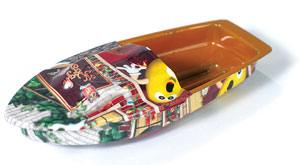 by: Tami O’Connor
by: Tami O’Connor
Although Robert Fulton is usually remembered as the inventor of the steamboat, it was actually John Fitch who built the first successful steamboat in 1787. Unfortunately, John Fitch ran into financial difficulties which opened the door for Robert Fulton to design and test the Clermont, which was the first commercially successful steamboat, in 1807. Since that time, there have been many improvements on the initial design, but the science behind the steamboat engine is fascinating.
Educational Innovations carries Putt Putt Steam Boats that are wonderful reproduction toys, which can be used to teach many scientific principles. The science behind how they work is rather complex and often disputed. We would be delighted to hear input from our teachers.
which can be used to teach many scientific principles. The science behind how they work is rather complex and often disputed. We would be delighted to hear input from our teachers.
How Do They Work?
One theory is that a heat source (small candle, or cooking oil and wick) heats the water in the boiling chamber creating a brief burst of steam that is expelled through the pipes in the rear of the boat. The force of the expanding gas (steam) pushes the boat forward. Since there is a limited amount of water in the chamber to start with, the exit of the gas creates an area of lower pressure in the boiling chamber. This allows the atmospheric pressure that is pressing down on the water to force more water into the chamber, allowing it in turn to be heated to boiling, and repeating the process again and again until the fuel is exhausted.
Suggested Activities for your Putt-Putt Steam Boat
Note: Use caution! The boat will get hot.
Run your Putt-Putt steam boat in a small pool or washtub.
- Have students predict how many times around washtub the boat will travel using just one candle or the amount of time each trip will take.
- Have your students calculate the average speed of the boat by measuring the distance around the test chamber, and timing each revolution.
- Have students determine if the speed of the boat changes as the fuel is consumed? Does it move more quickly at the beginning, middle or end of the life of the candle? Other variables could include adding additional weight to your steamboat or changing the temperature of the water you boat travels through. Ask students to brainstorm additional variables, which could potentially affect the speed of the boat through the liquid.
- Use alternate fuels in your boat. Cooking oil and a scrap of cotton fabric works well. As do small wood shavings. Does the type of fuel affect the speed at which the boat travels? Do some fuels make the boat go further? Go faster? Both? Neither? Make a graph of fuel type, vs. speed and distance.
- For younger students, simply use two different boats to compare variables. Have the boats race each other changing only one variable at a time.
There are a number of websites that give instructions on how to build your own steamboat. This is an excellent idea for a science fair project!
A Note on Conservation
Perhaps we should have called this section “A note on CANservation”. Take a close look at our boats – you will discover that they are made from metal stamped out of a wide variety of cans and containers (some will be misprinted paint cans, others holiday gift tins, still others can be very hard to figure out). This is a wonderful example of how materials that might have had to be re-melted or even end up in landfills can be used to make products that are fun and interesting.
if was possible to double the fire – the energy (not the candles because of the increasing weight), you double the speed as result?